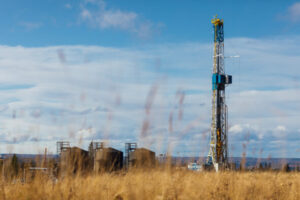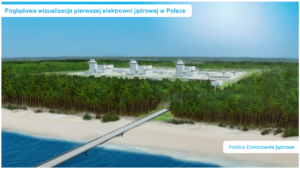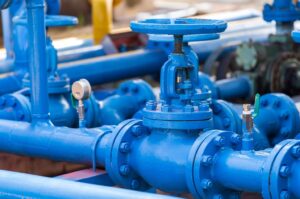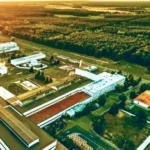Amidst the global struggle against the pandemic, the Nord Stream 2 (referred to NS2 or NS2 AG) saga continues to unfold. On 20th December 2019 the USA imposed sanctions against the pipeline and on the following day the Nord Stream 2 construction came to an abrupt stop. Until then the 94 percent of pipeline had been built. In response to the sanctions, Gazprom, the owner of NS2, has announced that it will finish pipeline using its own resources, yet in April 2020 construction is still on hold – argues Grzegorz Krzyżanowski from The European University Institute.
In the meantime, most of work related to the Nord Stream 2 is not taking place at the open sea, but in the coziness of lawyers’ cabinets. Therefore, in 2020 the company has been mostly engaged in argument-laying rather than pipe-laying activity. On 10th January 2020 Nord Stream 2 AG, pursuant to Article 49a of the Gas Directive (2009/73/EC), applied to the German Network Regulator (BNetzA) to obtain a derogation from the provisions of the Directive 2009/73/EC. BNetzA has to decide on this issue till 24 May 2020.
Obtaining a derogation would allow Nord Stream 2 to operate without full compliance with the Third Energy Package. Hence, the pipeline would not be required to apply such key provisions as third party access, non-discriminatory and transparent standards (including those on tariffs regulations), and ownership unbundling.
The stakes are high
According to the amended the Gas Directive, the pipelines between the Member States and a third country can request either a derogation (existing pipelines) or an exemption (new pipelines).
While Nord Stream 2 requested to be granted a derogation, it is crucial to note that this pipeline is not eligible to obtain it. Nord Stream 2 cannot be treated as an existing pipeline because it does not fulfill the condition of being completed by the time when the amended Gas Directive came into force, that is 23 May 2019. It is a fact that by that date only 40 percent of the pipeline was constructed.
Then, it seems reasonable to pose such question: Why is that despite of not being completed, Nord Stream 2 applied for a derogation, and did not request an exemption that it is qualified for as a new pipeline? In order to answer, it is useful to highlight other significant differences between those two terms. First of all, derogation is simpler, and it has less conditions attached to it. For instance, it does not entail a direct engagement of the Commission in the awarding procedure (it is optional for the EC to act as an observer if it is asked by a Member State that has the capacity to grant derogation).
In the case of an exemption, the Commission’s role is more prominent. The EC analyses the application and it may ask a Member State authority “to amend or withdraw the decision to grant an exemption” [1].
Another difference is the extent of the requirements that have to be met to be awarded either a derogation, or an exemption. Article 49a stipulates that derogation cannot be harmful to the effectiveness and competitiveness of the internal gas market, nor to be detrimental to EU’s security of supply. In the matter of seeking exemption, an investment needs to adhere to more rigorous obligations. It is not only about being “not detrimental”, but also in order to be exempted, an investment must be conducive to enhancing the security of supply and competition. Additionally, when deciding upon exemption the Member State’s authority should consult “the national regulatory authorities of the Member States the markets of which are likely to be affected by the new infrastructure” [2].
By comparing the rules of derogation and exemption, it is easy to infer that the latter appears less favorable to Nord Stream 2 than the derogation. Proving that Nord Steam 2 enhances competition and security of supply may be as difficult as proving that the pipeline was completed by 23 May 2019. In addition, if NS2 had applied for an exemption it would have to deal with the objections from other Member States’ regulatory authorities. Not to mention that in the end of the process, the pipeline would have to deal with final decision taken by the Commission. Hence, the decision of NS2 to request derogation was made instead.
The problem of “completeness”
In April 2019, the European Parliament and the Council agreed on a text of the revised Gas Directive. At that time NS2 had realized that their undersea pipeline would end up being subjected to EU regulations. Incidentally, in the adopted version the Directive’s regulatory powers were significantly watered down compared to what the EC proposed back in 2017. Yet, it was still unacceptable for Nord Stream 2.
Although NS2 and its supporters were not able to completely block unfavorable amendment, soon they realized that obtaining derogation would be a solution to evade obligation to apply EU rules. There was only one hurdle. The pipeline had to be completed by 23 May. While it was impossible to do so on such a short notice, they resolved to question the term “completed pipeline”. In April 2019, NS2 started to undermine amended Gas Directive and pointed out the possibility of discriminatory treatment of the project. The correspondence between NS2 and the EC serves as a compelling evidence of how their reasoning and narrative were formulated. And NS2 strategy was hybrid: mixing inquiries about derogation with the threats of legal action.
By analyzing NS2 activity one can infer that the company employs three methods in order to achieve its goals:
- Creating confusion and challenging existing regulations: Asking what does it mean “completed pipeline”?
- Playing the victim and blaming the others: Declaring that NS2 is being treated in a discriminatory way. Complaining that EC refuses to explain EU’s rules and fails to be more cooperative.
- Pushing its own narrative: advancing the claim that NS2 is “economically completed”.
-
Creating confusion and challenging existing regulations
The first letter from Nord Stream 2 to the EC (dated 12 April 2019) focused on two main issues. First one was requesting clarification on how the derogation would be applied. Nord Stream 2 AG claimed that:
“The Derogation would allow Germany to derogate from these rules but it this depends on the interpretation of the concept of a “completed” transmission line. The relevant section of Nord Stream 2 will be substantially “completed” if the amendment enters into force by summer 2019 but it will be not operational” [3].
This section illustrates how NS2 has been trying to make something as clear as “completed pipeline” open for an interpretation. Then it introduced the notion of “being substantially completed” which would, however, not entail the ability to operate. That was to demonstrate that certain level of “completeness” can be considered without taking into account “operability”. In the next paragraph NS2 was more explicit in its intentions and stated that:
“[T]he Derogation is provided for to allow recovery of the investment made and to protect legitimate expectations of investors. Such concerns are not materially different for a “completed”, “half-completed” or “almost completed” pipeline. The problem is the same in all these scenarios, namely that considerable financial resources have been invested in infrastructure and investment risk undertaken and that the rules for owning and operating this infrastructure are suddenly fundamentally changed by new regulation. In the case of Nord Stream 2 the final investment decision was taken several years ago, billions of euros have been spent and almost all commitments have been entered into. The design of construction and operation of the pipeline was based on existing legislation” [4].
What NS2 argued in that section is twofold. Firstly, it downplayed the case of “completeness” as it introduced the notions of “half-completed” and “almost-completed” and suggested that there’s no real difference between them because being eligible for derogation should be assessed by the purpose of derogation, which boils down to safeguarding the prospects of the investment. In the next passages NS2 maintained that the EU rules “suddenly” changed and thus put the investment to risk. If NS2 was so eager to elaborate on the meaning of “complete” it should also explain what “suddenly” meant. One can use many words to describe the EU legislative process but “suddenly” is not one of them. In this particular case it was around a year and a half between the date when the Commission’s legislative proposal was released (8 November 2017) and the time when amended Directive entered into force (23 May 2019).
-
Playing the victim and blaming the others
The second issue brought up in the letter of 12 April was a notification that if NS2 is not qualified as eligible for a derogation, it would mean the violation of the Energy Charter Treaty (Articles 10 and 13), which would be tantamount to the discriminatory treatment. That said, NS2 also benevolently expressed that there is a possibility to “reach an amicable settlement” [5] with the Commission. In the following correspondence both parties agreed to hold a meeting to discuss disputed issues (the EC replied on 13 May, and NS2 answered back on 27 May).
In the next letter (8 July) NS2 referred to the meeting that took place on 25 June 2019 and reported its conclusions. One of the issues brought up by NS2 was that the company did not receive a satisfactory clarification from the EC on how the derogation should be applied. Long story short: NS2 wanted to know explicitly whether Germany could grant the pipeline with derogation. The Commission replied by saying that it was up to Germany to decide upon the derogation once the request is submitted. The EC added that Member State should comply with the EU law, and if not, the EC had the right to intervene.
Further in the same letter NS2 argued that: “it does not seem credible that the EU is objectively incapable of explaining “completed before 23 May 2019” in a measure that was recently adopted by its legislature. The EU’s refusal to do so puts both Member States and investors in a difficult position, and constitutes a further breach of the ECT (..)” [6]. Then it openly spoke on behalf of the EU Member State by stating: “In the case of Germany, it is left in a position of uncertainty about the correct implementation and practical application of the Amending Directive, with all the legal this may entail” [7].
It’s noteworthy how deeply NS2 was preoccupied with the Germany’s capacity to interpret EU law and preferred to present German energy authority with the ready-to-use solution. Obviously, if such solution fell in line with NS2 interests it would be indisputable. Otherwise, it would be fiercely opposed for arguing against NS2’s rationale. At the end of the message, NS2 has yet again warned the EC to initiate legal action due to alleged violation of ECT.
In a following letter (26 July), the EU responded to NS2 complaints from 8 July and rebutted accusations. The Commission referred to the Gas Directive’s provisions and underlined that it is not its duty to decide about derogations as it has been clearly assigned to the Member State authority. Moreover, it explained that: “It is thus not for the Commission to anticipate how the German authorities will decide in the event that NS2AG applies for a derogation, nor it is for the Commission to decide for NS2AG whether it should apply or not for a derogation” [8].
The last message of the series was sent by NS2 on 6 August. In this letter NS2 basically reiterated most of its complaints against the EC, including the one saying that: “[T]he EU’s deliberately ambiguous communication on this point with NS2AG is a further violation of its obligations under the ECT” [9]. It’s also worth mentioning that NS2 eventually admitted: “We note in this respect that a number of public EU documents indicate that Nord Stream 2 would not be eligible for a derogation […]”[10] , and “in view of your response it appears that there is no point in litigating these matter further in correspondence, and we must conclude that the EU takes the view that Nord Stream 2 is not eligible for a derogation” [11].
One may infer that the company wanted to enforce on the Commission producing an opinion which could be considered as “a recommendation” to be acted upon. If the EC had taken the bait and indicated more directly about the non-applicability of derogation to the pipeline, NS2 would have used the Directive against it by claiming that the EC had overstepped its role. The EC was well aware of it and avoided any explicit declarations except those strictly referring to the provisions of the Gas Directive.
The last NS2 letter ended with the following notice: “NS2AG will consider all options available and necessary to protect its interests, including the right to initiate arbitration proceedings against the EU pursuant to Article 26 of ECT without further notification to you” [12]. This warning has materialized on 26 September 2019 when NS2 officially triggered a case of Investor-State Dispute Settlement (ISDS) against the EU.
Still, even before launching that arbitration case, Nord Stream 2 AG filed two legal actions against the European Parliament and the Council with the General Court of the EU.
The first one (Case T-526/19) was submitted on 25 July with the claim to annul the revised Gas Directive (2019/692). NS2 argued that the Directive infringed the EU principles of equal treatment, proportionality, legal certainty; it also indicated that the adoption of the Directive was the misuse of powers [13].
The second one (Case T-530/19) was lodged on 26 July with the claim to annul the provisions of the Gas Directive (2019/692) concerning the deadline for decision about the derogation (24 May 2020). NS2 said that the deadline is “excessively short” [14] and it is a breach of the principles of proportionality, and legitimate expectations [15].
-
Pushing its own narrative
Having undertaken all legal actions against the EU, on 10th January 2020 NS2 applied to BNetzA to obtain a derogation. Nord Stream 2 AG maintained that the pipeline is “economically complete” and it is being quoted to argue that „On the effective date of May 23, 2019, the Nord Stream 2 pipeline had been completed from the perspective of economic functionality”. Claims that aim at reducing the whole pipeline only to its financial aspects amounts to tinkering with semantics and distorting the logic. Moreover, the contention that the vaguely defined concept of “economic functionality” [16] is enough to qualify the whole pipeline as “complete” makes out of the entire argument an epitome of legal sophistry.
Conclusions
Overall, NS2 has initiated a series of legal disputes and it has contested a variety of aspects of the Directive (compliance with ECT, general compliance with EU rules, and its specific regulations). Nonetheless, it has still applied to obtain a derogation which seems to be a deliberately crafted strategy. It is predicated on the anticipation that one of the disputes would lead to a favorable ruling or, at least, the judgment that would indicate kind of ambiguity in the Directive. If it happens, the company would try to pit legal rulings against each other with a view to exploit any dissenting opinions in NS2 favor.
As for the argument that NS2 was “economically completed” by 23 May 2019: if you need an additional word to describe a thing that is complete, there two options to consider: either that word is needless (as in “fully complete”) or that thing is not complete at all (“almost complete”).
The claim that “sudden” change of the EU jeopardized the whole investment is neither credible nor convincing. To prove that point it is enough to quote several facts that speak volumes that the NS2 regulatory and political investment risks were well known from the very beginning.
To start with, the Nord Stream 2 shareholders agreement was signed on 4th September 2015. Given the range of issues and controversies (legal, political, environmental etc.) the first Nord Stream (it was completed in 2012) had raised, the decision to construct the second one seemed like rubbing salt into the wound. It was highly foreseeable that that building of Nord Stream 2 one would be met with resistance.
Secondly, the geopolitical conditions were far from favorable. In September 2015 Russia has been involved in the war in eastern Ukraine and had annexed Crimea. It was obvious that any Russian investments would undergo a detailed screening and will be given extra attention.
Thirdly, already back in November 2015, the EC declared that:
“The Commission takes note of the plans of commercial companies to build further pipelines connecting Russia and Germany through the Baltic Sea. If built, Nord Stream 3 and 4 would not give access to a new source of supply and would further increase transmission capacity from Russia to the EU, while even now this is only used at 50% rate. These pipelines will have to comply fully with EU law. The Commission will assess any such project against the European regulatory framework on its own merits” [17].
Hence, the EC has indicated that it is fully aware of the developments of NS2 and its potential properties such as undermining EU’s policy of diversification routes and sources of gas supply; it has also underlined the expectations of the pipeline’s compliance with the EU regulations.
Fourthly, based on the objections raised by the Polish competition authority (UOKiK) in August 2016, the joint venture agreement among six companies planning to build Nord Stream 2 had to be cancelled (November 2016). Thus, in April 2017 the project’s funding model changed: Gazprom remained as the only shareholder, and the Western European companies (and former shareholders) have become financial investors. It was already an important sign that the project has triggered serious legal concerns.
Fifthly, already in September 2017 in State of the Union letter of intent to the Presidents of the EP and the Council, the President of the EC mentioned as one of the upcoming initiatives “a proposal on common rules for gas pipelines entering the European internal gas market” [18]. Subsequently, in November 2017 the European Commission released its legislative proposal to amend the Gas Directive. The proposal stipulated that all pipelines between the EU and third countries should fully comply with the EU law.
Finally, Nord Stream 2 construction did not start until 2018 [19], and the last construction permit was issued only in October 2019 (by Denmark).
To recapitulate, it is clear to see that there were plenty of perceptible and tangible indicators that there would be attempts to either stop Nord Stream 2 altogether, or to make it compliant with EU law by amending the Gas Directive. As to explain the rationale of NS2, there are two options to consider. Either NS2 was acting carelessly by seriously underplaying the highly feasible investments risks, or NS2 deliberately and consciously endeavored to exploit legal gaps but has largely overestimated its chances in doing so. The latter seems to be far more plausible. NS2 was fully aware of the investments risks and it has been trying to intentionally bypass EU regulations. Finally, given its record of endeavors aimed at challenging the provisions of the Gas Directive and the line of argumentation that NS2 has employed, it is unlikely that the company will manage to obtain a derogation.
[1] Article 36, Directive 2009/73/EC of the European Parliament and of the Council of 13 July 2009 concerning common rules for the internal market in natural gas, https://eur-lex.europa.eu/legal-content/EN/TXT/?uri=CELEX:02009L0073-20190523
[2]Article 36, Directive 2009/73/EC of the European Parliament and of the Council of 13 July 2009 concerning common rules for the internal market in natural gas, https://eur-lex.europa.eu/legal-content/EN/TXT/?uri=CELEX:02009L0073-20190523
[3] Letter from Nord Stream 2 to the Commission, 12.04.2019, https://trade.ec.europa.eu/doclib/docs/2019/july/tradoc_158069.pd_Redacted.pdf, p. 2
[4] Ibid, pp. 2-3
[5] Ibid., p. 1
[6] Letter from Nord Stream 2 to the European Commission, 08.07.2019, https://trade.ec.europa.eu/doclib/docs/2019/august/tradoc_158304.pdf, p.2
[7]Ibid., p.2
[8] Letter from the European Commission to Nord Stream 2, 26.07.2019, https://trade.ec.europa.eu/doclib/docs/2019/august/tradoc_158305.pdf, p.2
[9] Letter of Nord Stream 2 to the European Commission, 06.08.2019, https://trade.ec.europa.eu/doclib/docs/2019/september/tradoc_158328.pdf, p.1
[10] Ibid., p.1
[11] Letter of Nord Stream 2 to the European Commission, 06.08.2019, https://trade.ec.europa.eu/doclib/docs/2019/september/tradoc_158328.pdf, p.2
[12] Ibid., p.2
[13] Action brought on 25 July 2019 – Nord Stream 2 v Parlement and Conseil (Case T-526/19), http://curia.europa.eu/juris/document/document.jsf?text=&docid=217585&pageIndex=0&doclang=EN&mode=lst&dir=&occ=first&part=1&cid=1285224
[14] Action brought on 26 July 2019 – Nord Stream v Parliament and Council (Case T-530/19), http://curia.europa.eu/juris/document/document.jsf?text=&docid=217585&pageIndex=0&doclang=EN&mode=lst&dir=&occ=first&part=1&cid=1285224
[15] Ibid.
[16] Elliott, S., “Nord Stream 2 hits back over Polish claims on pipeline’s legal status”, S&P Global Platts, https://www.spglobal.com/platts/en/market-insights/latest-news/natural-gas/032420-nord-stream-2-hits-back-over-polish-claims-on-pipelines-legal-status, 23.03.2020
[17] Communication from the Commission, State of the Energy Union 2015, https://eur-lex.europa.eu/legal-content/GA/TXT/?uri=CELEX%3A52015DC0572&2nd-language=et, 18.11.2015
[18] State of the Union 2017 Letter of Intent to Presidents of the EP and the Council, https://ec.europa.eu/commission/sites/beta-political/files/letter-of-intent-2017_en.pdf, 13.09.2017
[19] Nord Stream 2, Construction, https://www.nord-stream2.com/construction/overview/








